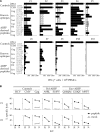Identification of cryptic MHC I-restricted epitopes encoded by HIV-1 alternative reading frames
- PMID: 15078897
- PMCID: PMC2211898
- DOI: 10.1084/jem.20031869
Identification of cryptic MHC I-restricted epitopes encoded by HIV-1 alternative reading frames
Abstract
Human immunodeficiency virus (HIV) 1 major histocompatibility complex (MHC) I-restricted epitopes are widely believed to be derived from viral proteins encoded by primary open reading frames. However, the HIV-1 genome contains alternative reading frames (ARFs) potentially encoding small polypeptides. We have identified a panel of epitopes encoded by ARFs within the gag, pol, and env genes. The corresponding epitopic peptides were immunogenic in mice humanized for MHC-I molecules. In addition, cytotoxic T lymphocytes recognizing these epitopes were found in HIV-infected patients. These results reveal the existence of atypical mechanisms of HIV-1 epitope generation. They indicate that the repertoire of epitopes recognized by the cellular anti-HIV-1 immune response is broader than initially thought. This should be taken into account when designing vaccine strategies aimed at activating these responses.
Figures






Similar articles
-
Designing and engineering of DNA-vaccine construction encoding multiple CTL-epitopes of major HIV-1 antigens.Vaccine. 2004 Apr 16;22(13-14):1672-82. doi: 10.1016/j.vaccine.2003.09.048. Vaccine. 2004. PMID: 15068850
-
Clustered epitopes within the Gag-Pol fusion protein DNA vaccine enhance immune responses and protection against challenge with recombinant vaccinia viruses expressing HIV-1 Gag and Pol antigens.Virology. 2005 Feb 20;332(2):467-79. doi: 10.1016/j.virol.2004.09.043. Virology. 2005. PMID: 15680412
-
An alternative translational reading frame encodes an immunodominant retroviral CTL determinant expressed by an immunodeficiency-causing retrovirus.J Immunol. 1998 Jan 1;160(1):39-50. J Immunol. 1998. PMID: 9551954
-
Identifying cytotoxic T cell epitopes from genomic and proteomic information: "The human MHC project.".Rev Immunogenet. 2000;2(4):477-91. Rev Immunogenet. 2000. PMID: 12361091 Review.
-
The influence of antigenic variation on cytotoxic T lymphocyte responses in HIV-1 infection.J Mol Med (Berl). 1998 Sep;76(10):699-708. doi: 10.1007/s001090050270. J Mol Med (Berl). 1998. PMID: 9766848 Review.
Cited by
-
The HIV-1 antisense protein (ASP) induces CD8 T cell responses during chronic infection.Retrovirology. 2015 Feb 10;12:15. doi: 10.1186/s12977-015-0135-y. Retrovirology. 2015. PMID: 25809376 Free PMC article.
-
The Hidden Enemy Within: Non-canonical Peptides in Virus-Induced Autoimmunity.Front Microbiol. 2022 Feb 10;13:840911. doi: 10.3389/fmicb.2022.840911. eCollection 2022. Front Microbiol. 2022. PMID: 35222346 Free PMC article.
-
Know thy immune self and non-self: Proteomics informs on the expanse of self and non-self, and how and where they arise.Proteomics. 2021 Dec;21(23-24):e2000143. doi: 10.1002/pmic.202000143. Epub 2021 Aug 9. Proteomics. 2021. PMID: 34310018 Free PMC article. Review.
-
New lane in the information highway: alternative reading frame peptides elicit T cells with potent antiretrovirus activity.J Exp Med. 2007 Oct 29;204(11):2501-4. doi: 10.1084/jem.20071986. Epub 2007 Oct 22. J Exp Med. 2007. PMID: 17954574 Free PMC article.
-
The antiviral factor APOBEC3G improves CTL recognition of cultured HIV-infected T cells.J Exp Med. 2010 Jan 18;207(1):39-49. doi: 10.1084/jem.20091933. Epub 2009 Dec 28. J Exp Med. 2010. PMID: 20038599 Free PMC article.
References
-
- Schmitz, J.E., M.J. Kuroda, S. Santra, V.G. Sasseville, M.A. Simon, M.A. Lifton, P. Racz, K. Tenner-Racz, M. Dalesandro, B.J. Scallon, et al. 1999. Control of viremia in simian immunodeficiency virus infection by CD8+ lymphocytes. Science. 283:857–860. - PubMed
-
- Barouch, D.H., J. Kunstman, M.J. Kuroda, J.E. Schmitz, S. Santra, F.W. Peyerl, G.R. Krivulka, K. Beaudry, M.A. Lifton, D.A. Gorgone, et al. 2002. Eventual AIDS vaccine failure in a rhesus monkey by viral escape from cytotoxic T lymphocytes. Nature. 415:335–339. - PubMed
-
- Allen, T.M., D.H. O'Connor, P. Jing, J.L. Dzuris, B.R. Mothe, T.U. Vogel, E. Dunphy, M.E. Liebl, C. Emerson, N. Wilson, et al. 2000. Tat-specific cytotoxic T lymphocytes select for SIV escape variants during resolution of primary viraemia. Nature. 407:386–390. - PubMed
Publication types
MeSH terms
Substances
LinkOut - more resources
Full Text Sources
Other Literature Sources
Research Materials

